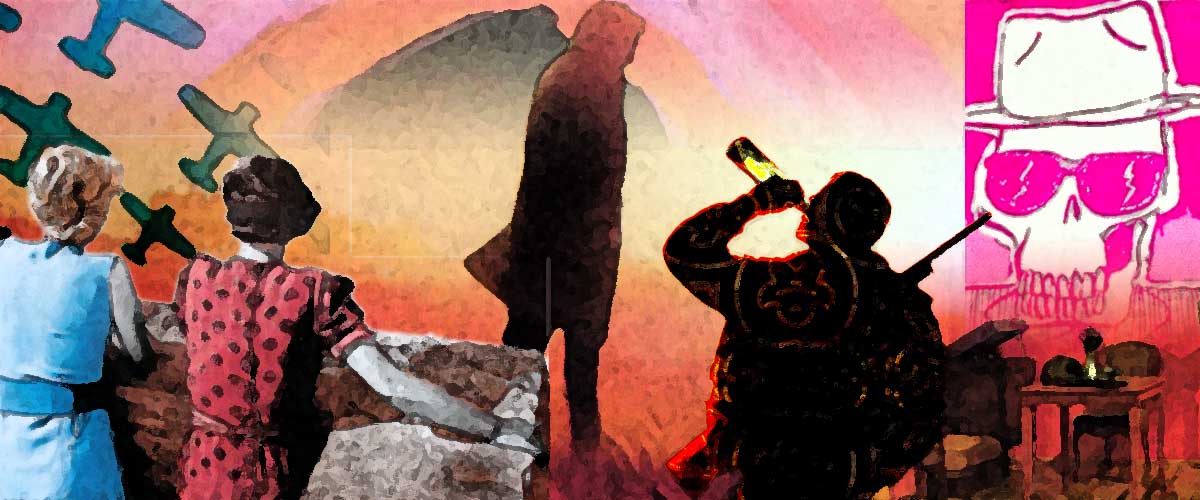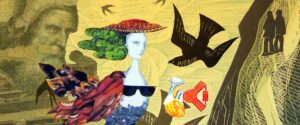My quarterly round-up of books read between June and September runs from Ian Rankin’s Heart Full of Headstones, via Georgi Gospodinov’s Time Shelter, to Belfast in the Second World War in These Days by Lucy Caldwell.
Click here to jump directly to the book list.
Headstones and Time Travel
My third reading quarter felt much more successful than the second. True, several titles were relatively short. (The Young Walter Scott Prize anthology, Adventures in Time Travel, and Tim Craig’s brilliant collection of flash fiction, Now You See Him, for example). On the other hand I read more than 3500+ pages this quarter. That’s close to the same total for Q2 (3800 pages). Easily more than the 2800+ I got through for the year’s first quarter. I completed 12 titles (and I’ve since completed a thirteenth, started during the month). My reading resolution goal of 50 titles completed during the year looks comfortably within reach.
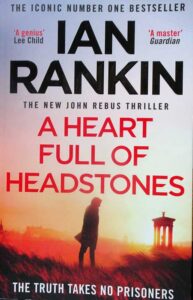
I picked up the latest Rebus novel, A Heart Full of Headstones, in an Oxfam bookshop while I was in England in May. I started reading it on the flight home and finished it inside six days. It’s a gripping story, well told, as you’d expect from Ian Rankin. Actually, I thought it was more satisfying than the previous title A Song for the Dark Times.
Walter Scott’s adventures
But the book I really want to talk about first is the anthology of historical fiction, Adventures in Time Travel. This is a collection of short stories, the runners-up and winners of the Young Walter Scott Prize for 2022. My sister and her husband visited the Borders Book Festival in Melrose while I was house-sitting (and mother-sitting) for them. The Walter Scott Prizes were awarded during the Book Festival, and they brought this one back for me.

The anthology collects the shortlist of ten stories. Five are by writers in the 11-15 year old category, five by writers 16-19 years old. Ellie Karlin from Bristol was the younger winner with “Mrs Fujita’s Living Room”. A story of two women waiting for the end of the war in Hiroshima just before the fall of the atom bomb. The winner in the older category was “Forever England” by Rosie Brooker of Solihull. In her story, an aristocrat survivor of the Dardanelles campaign is pestered by an old school-mate, who avoided the war, for his memories of Rupert Brooke the poet, a man who died less than heroically on his way to the war in Anatolia.
Both stories were good, but for my taste the best story in the book was by one of the runners-up. In “White Fox”, by Atlas Wayland Eden (and there’s a name to conjure with), the last of the Emishi people, the aboriginal inhabitants of Honshu, loses his life out hunting. (Hunting a white fox of course.) Set in the seventh century, on the border between fantasy and history, it reminded me of some of Le Guin’s Orsinian stories.
The remaining stories in the anthology were also pretty good, but all clearly written by children (some of them with a taste for purple prose). Though all of them were probably better than I could have managed even in my 20s.
Time travel to the time shelter
Time Shelter, by Georgi Gospodinov (translated by Angela Rodel) won the 2023 International Booker Prize. Gospodinov is the first Bulgarian winner. This was a birthday present from Mrs SC, and in part a family in-joke. (We first met in Bulgaria.) Joke or not, I quite enjoyed reading it. In places, it was very good indeed.
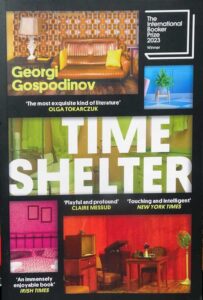
It’s an extended exploration of an idea that gets out of hand. The idea (which is certainly true) is that people with dementia are helped if they can be put in situations, in environments, that preserve aspects of their past. Images, objects, sounds and smells help them to return to memories of their childhood or youth. As a consequence many feel happier and are less confused.
The book starts out from the premise that rooms and then sets of rooms can be turned into living museums of the different decades of the 20th century. People with dementia can visit the rooms, stay in them, and feel themselves in harmony with their youthful selves.
In the novel, the author is himself a character. He assists his alter ego, Gaustine, the driving force behind the treatment. But what starts out as help for the demented, develops into holiday resorts for the nostalgic. The nostalgia spreads. It sweeps across Europe and leads to a series of referendums. Whole countries vote to live in specific decades of the past.
I’m reminded of Brexit, inevitably. Also of the rise of populist political parties that look to fantasised golden eras when there were no immigrants and everyone had a job and a place.
In the way of many absurdist novels, Gospodinov takes his idea to an extreme, and then faces a difficulty in concluding it. In the final part of the book reality and fiction break down and intermingle. Successfully, I think. At least, I’m not sure how else he could have ended it.
Natural behaviour

This quarter’s Swedish language book was Naturliga Beteenden (“natural behaviour”) by Golnaz Hashemzadeh Bonde. Rather like my friend Gail Aldwin’s novel, The Secret Life of Carolyn Russell, this is a story told in two parallel timelines in alternating chapters. In one sequence, the adult protagonist, Lily, gives birth to her first child, and we follow her through her earliest overprotective months of motherhood. In the second sequence, Lily is a little girl living with her own mother, who is neither protective nor loving. Lily’s mother cares for her child only insofar as she works long hours, taking unsocial shifts, in order to pay for their home and put food on the table. Child Lily wants so much more, but accepts, eventually, that what she gets is all her mother can give.
The alternating chapters cast light on Lily’s adult behaviour. Her determination not to be like her mother; her fear she will become exactly like that. A pet kitten the child Lily cares for becomes pregnant and then rejects her babies. Despite all Lily does to help, the kittens die. This underlines the “natural behaviour” of mother/child rejection.
I thought this was a very good novel. I wouldn’t call it comfortable or even reassuring (though it does end on a note of hope for adult Lily). As ever, reading in Swedish, I’m not in a position to judge the quality of the language. However the structure of the story worked very well. Though I found myself wondering how child Lily had grown into adult Lily. Also there is a neighbour, Gunilla, who plays the role of granny/aunty to child Lily. I wondered what happened to her, and why Lily as an adult had not remained in touch.
Book hunt to dove hunt
Golnaz Hashemzadeh Bonde was one of the authors on the Faculty at the Stockholm Writers Festival in August. She writes in Swedish, but the Festival took place in English, so one of her books was available to buy in English translation. I bought it, but then thought, since I can, I really ought to read her in Swedish. So I went on an expedition. It took me through three different bookshops, but left me with Naturliga Beteenden, her most recently published novel.
Another of the Faculty writers was Johnny Shaw, whose first novel, Dove Season is named for the hunting season that is the backdrop for the novel. Hunting for books, hunting doves – it’s the best segue I’ve got!
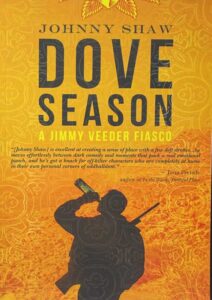
Before coming to novel writing Johnny Shaw was (maybe still is) a writer of film scripts. This is not to say that Dove Season is a book of dialogue, though there is a lot of good dialogue in it. But it’s written in the first person and the I of the book, Jimmy Veeder, has a distinct personality that is established from the very beginning through his use of language. “The desert brings out the desperate worst in a thing,” says Jimmy. “In the desert even the plants have chips on their shoulders.”
Calexico to Mexicali and on to Belfast
At the Festival, Shaw talked about his novels and their setting. As I understand it, all his books focus on the people and places of the Mexico/California borderlands, where Shaw himself grew up and still has family. Jimmy Veeder is a good man. Mostly good. If not always very clever. Partly through his own actions, he often finds himself in difficult circumstances, or is often caught out by events. Some of the circumstances are dire, some of the events are pretty awful. There is a constant strain of black humour that runs through the novel and makes it entertaining at the same time as the events it describes are suspenseful. It took me awhile to get into. It’s not the sort of book I’d normally read, but I enjoyed it, and I read out the last third very quickly, wanting to know what would happen.
I started this post (more or less) with the junior Walter Scott Prizewinners. I choose to finish with the novel that won the adult Prize: These Days, Lucy Caldwell’s novel of the Belfast Blitz.
Four Raids
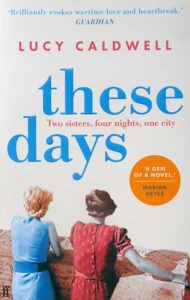
These Days follows the fate of a middle-class Belfast family, and in particular the two daughters, Emma and Audrey, in April and May 1941. This was when the city was hit, in swift succession, by four bombing raids. The raids are the section titles that give the book its chronological structure: The Dockside Raid, the Easter Raid, The Fire Raids. The family survive the trials and their house comes through intact. Working-class families that serve or touch on the core family are less fortunate.
Wee Betty, the housemaid, is buried with all her family when their house collapses after the Fire Raids. Mrs Price, the housekeeper, loses her home and some of her relatives. Maisie, the little girl, only six, the daughter of a random working-class family that drifts into Audrey’s orbit, is traumatised and bombed out. Audrey herself, aged 20 and a secretary at a firm in town, is engaged, then breaks off her engagement with a doctor colleague of her father’s. Meanwhile Emma, aged 19, a volunteer nurse, is discovering her sexuality only to lose her girlfriend, Sylvia, in the Easter Raid.
The relationship between their mother Florence and father Philip, housewife and doctor, one born Catholic, the other Protestant and married across the divide, gives a deeper historical perspective.
I found this a moving and engaging read. I wanted to know what would happen and feared the worst. Initially I felt thrown by the shifting points of view, especially the early shift to Maisie and her unrelated working-class family. Though it all fitted together well in the end.
The novel starts with a couple of very well chosen quotes. It’s Lewis MacNeice who gives the book its title: “These days, though lost, will be all your days.”
Headstones and … tailstones?
As so often, I find that I’ve run on too long and have not covered all the books I wanted to. The Secret Life of Carolyn Russell has its own special review, as does Stephen King’s memoir. My plan is to write a special review of MR Carey’s Koli trilogy once I’ve read the third volume. That will come, I hope, sometime before Christmas. And maybe, you never know, I’ll also managed to write a special review for Tim Craig’s flash fiction collection. Watch this space!
Book list
(The books are listed in the order in which I finished them.)
- A Heart Full of Headstones by Ian Rankin (crime fiction, 385 pages, read in 6 days)
- Adventures in Time Travel – Young Walter Scott Prize Anthology (historical fiction, 87 pages, 3 days to read)
- The Secret Life of Carolyn Russell by Gail Aldwin (mystery, 284 pages, read in 5 days)
- The Book of Koli by MR Carey (SF/post-apocalypse, 376 pages, read in 9 days)
- A Book of Days by Patti Smith (meditations & photography, 386 pages, read in 7 days, but still re-reading bit by bit)
- Now You See Him by Tim Craig (flash fiction anthology, 79 pages, 4 days)
- Time Shelter by Georgi Gospodinov, translation by Angela Rodel (literary/speculative fiction, 302 pages, 10 days to read)
- On Writing: A Memoir of the Craft by Stephen King (what it says on the tin, 383 pages, 6 days to read)
- Naturliga Beteenden by Golnaz Hashemzadeh Bonde (literary fiction, 180 pages, 6 days to read)
- Dove Season by Johnny Shaw (black comedy, 378 pages, read in 9 days)
- These Days by Lucy Caldwell (historical fiction, 275 pages, read in 6 days)
- The Trials of Koli by M R Carey (SF/post-apocalypse, 445 pages, read in 8 days)
Read more …

